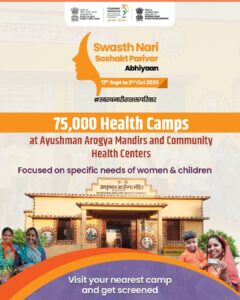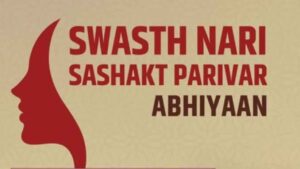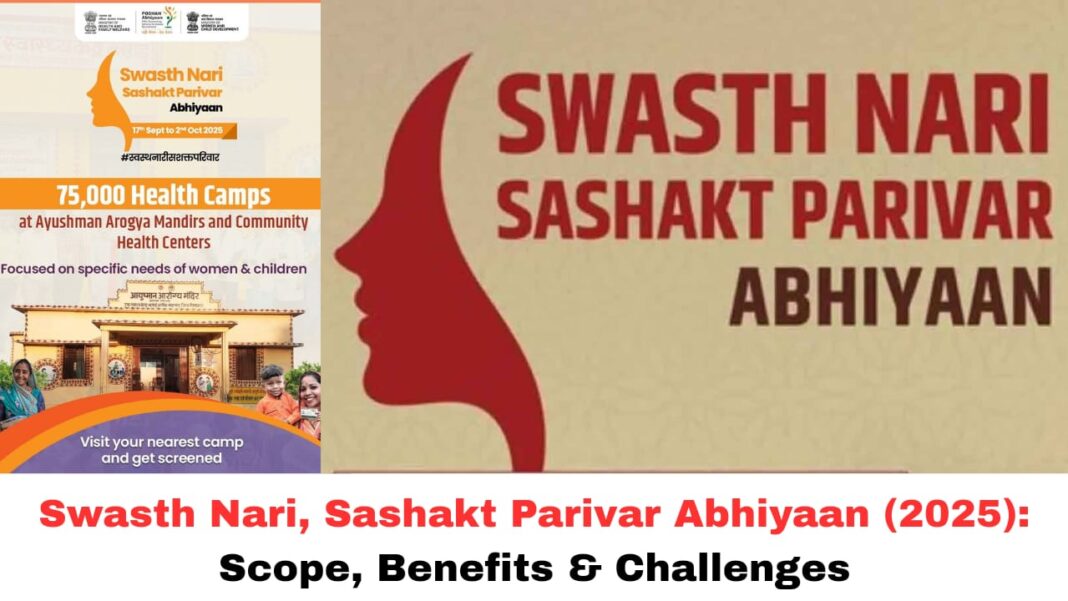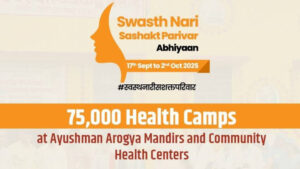Digital News Guru National Desk:
Swasth Nari, Sashakt Parivar Abhiyaan: India’s New Health Push for Women & Children
On 17 September 2025, Prime Minister Narendra Modi launched “Swasth Nari, Sashakt Parivar Abhiyaan” (Healthy Woman, Empowered Family Campaign) from Dhar, Madhya Pradesh. The initiative, carried out alongside the eighth Rashtriya Poshan Maah (National Nutrition Month), marks what the government describes as the largest health outreach programme ever for women and children in India.
Objectives & Themes
The campaign is designed to ensure better preventive, promotive, and curative health services for women, adolescent girls, and children. Key components include:
- Early screening and treatment of non-communicable diseases (NCDs) such as hypertension and diabetes.
- Testing for anaemia, tuberculosis, and sickle cell disease, especially in tribal or under-served regions.
- Emphasis on maternal, child, and adolescent health: antenatal care, immunisation, nutrition, menstrual hygiene, lifestyle and mental health awareness.
- Community mobilisation and awareness drives, including promotion of healthy diet, lifestyle choices, and voluntary blood donation.

Scale and Duration
- The campaign is scheduled to run from 17 September to 2 October 2025, aligning with Poshan Maah.
- More than 1 lakh health camps (i.e. 100,000+ camps) are to be organised across the country in this period, being held at Ayushman Arogya Mandirs, Community Health Centres (CHCs), District Hospitals, and other government health facilities.
- The campaign also involves daily health camps in all government health facilities.
Key Messages from Leadership
PM Modi, addressing the gathering in Dhar, laid great emphasis on the role of women in national development. Among his statements:
“Our mothers and sisters, our Nari Shakti, are the main Aadhar (pillar) of our Rashtra Pragati (national development). If a mother is healthy, the whole family stays healthy.”
He described the programme as a Maha Abhiyaan (grand campaign) directed towards women-led development. Modi urged women to make use of the health camps, highlighting that all tests and medicines will be free of cost and that no woman should suffer from serious illness due to lack of awareness or resources.
Implementation: Who is Involved
- The drive is jointly spearheaded by the Ministry of Health & Family Welfare (MoHFW) and the Ministry of Women & Child Development (MoWCD).
- Frontline health workers (ASHAs, ANMs), Anganwadi workers, Self Help Groups (SHGs), PRIs (Panchayati Raj Institutions), urban local bodies, youth groups, and volunteers will be mobilised for community engagement.
- Central government institutions like AIIMS, defence and railway hospitals, ESIC hospitals, CGHS and other Institutes of National Importance will also play a role to ensure specialist services and reach to more remote areas. Private hospitals have been called upon to participate as well.
Why It Matters
India has over the years made progress in improving women’s and children’s health — reductions in maternal mortality, increasing immunisation coverage, better nutrition in many regions. However, challenges persist:
- High rates of anaemia among women and girls, especially in rural and tribal districts.
- Increasing prevalence of non-communicable diseases among adults, which can begin in adolescence.

- Gaps in access: remote areas, under-served communities, and marginalized groups often have weaker health infrastructure.
- A need for behaviour change around nutrition, lifestyle, hygiene, menstrual health, and mental health, which are often under-prioritized.
By combining outreach (through camps), awareness, screening, free or subsidised care, and community involvement, the Abhiyaan attempts to close several of these gaps. It also aligns with global and national goals of reducing infant mortality rate (IMR), maternal mortality rate (MMR), and eliminating preventable disease burdens.
Early Actions & Local Impact
Already, signs of on-ground activity are visible:
- In Gujarat and Vadodara, a special women’s OPD has been launched at SSG Hospital, offering screening for diseases including breast and cervical cancer, TB, anaemia, reproductive health, diabetes, etc. Over 95 women availed services on the first day.
- In Noida, Union Minister Nitin Gadkari inaugurated drives to screen women for cancer, hypertension, diabetes, and anaemia, under the campaign.
- In Uttar Pradesh, the state is deploying over 20,000 health camps across all 75 districts, coupled with other support measures for Anganwadi workers (including pay hikes & smartphones) to strengthen service delivery.
- In Mumbai-North, mammography units are being deployed to screen women in slum areas; nutritional support is being emphasised for pregnant women.
- In Bengaluru and some southern cities, nearly 12,000 free ECG screenings for women were done in one day across Narayana Health hospitals to boost awareness about cardiovascular health.
Challenges & Considerations
While ambitious, the programme will need to address several potential challenges for its success:
- Logistics and Reach: Ensuring camps are set up in remote and tribal regions, maintaining supply chains for medicines, staffing, and transport will be a big test.
- Awareness and Uptake: Even when services are free, awareness about diseases, trust in the system, and willingness to attend screenings (especially for sensitive health issues) can be low, especially among marginalized women.
- Quality and Follow-Up: Screening is one part — ensuring proper diagnosis, treatment, counselling, and follow up (for example, in chronic diseases or cancer) is critical.
- Healthcare Infrastructure: Some regions have weak infrastructure—lack of specialist doctors, diagnostic labs, etc. Ensuring that government hospitals and partner private hospitals can deliver the required services is essential.
- Monitoring & Accountability: For an initiative of this scale, robust monitoring, feedback, and course correction will be necessary. Data collection, transparency, and involvement of local communities will help.
Significance & Long-Term Outlook
- Symbolically, launching this initiative on the Prime Minister’s 75th birthday, and aligning it with Poshan Maah, underscores the priority accorded to women and child health by the government.
- It represents a significant step in integrating preventive health into public consciousness — for diseases that often manifest silently or are neglected until advanced stages.
- If implemented well, it could strengthen India’s public health architecture, especially for women’s and maternal health, contributing to lower maternal and infant mortality, better nutritional outcomes, reduced disease burden of chronic illnesses, and improved quality of life.
- The push for “Jan Bhagidari” (people’s participation) also suggests that this is intended not just as a top-down programme but one with community ownership.
Conclusion
Swasth Nari, Sashakt Parivar Abhiyaan has the potential to become a landmark campaign for improving health outcomes of women, adolescent girls, and children in India. Its ambition in scale, its focus on preventive & promotive health, and its integration of nutrition, lifestyle, and disease screening all point towards a holistic approach. The coming weeks will be a test of how well plans translate into on-ground impact, especially in under-served areas. For many women and families, this campaign could make a real difference — if the promise of access, awareness, and timely quality care is fulfilled.
You May Also Read: Bay of Bengal Missile Test Alert: India Plans Test Under 1,500 km Range









